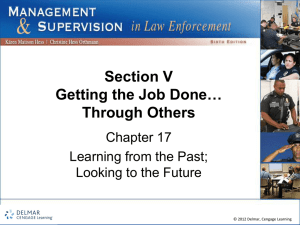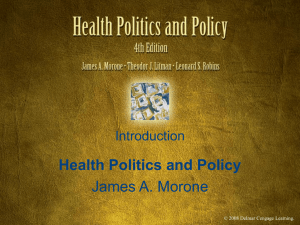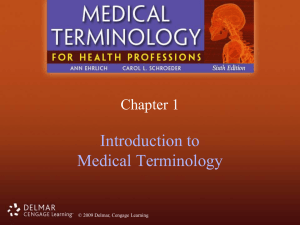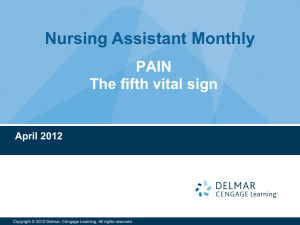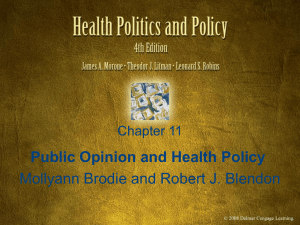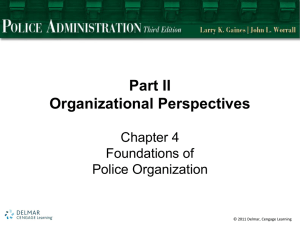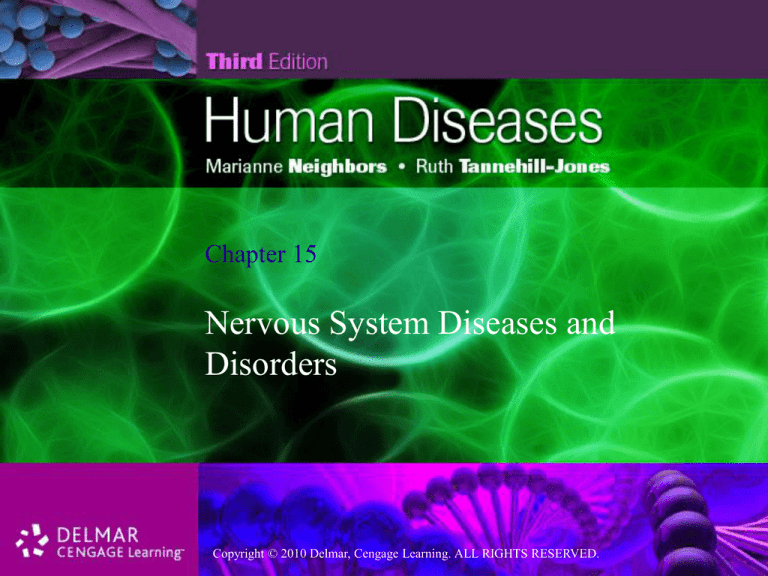
Chapter 15
Nervous System Diseases and
Disorders
Copyright
Copyright
© 2010
© 2010
Delmar,
Delmar,
Cengage
Cengage
Learning.
Learning.
ALLALL
RIGHTS
RIGHTS
RESERVED.
RESERVED.
Anatomy and Physiology
• Nervous system
– Brain, spinal cord, and nerves
– Central nervous system (CNS)
• Brain
• Spinal cord
– Peripheral nervous system (PNS)
• Autonomic nervous system
• Cranial and spinal nerves
Copyright © 2010 Delmar, Cengage Learning. ALL RIGHTS RESERVED.
Common Signs and Symptoms
•
•
•
•
•
Headache
Nausea and vomiting
Weakness
Mood swings
Fever
Copyright © 2010 Delmar, Cengage Learning. ALL RIGHTS RESERVED.
Common Signs and Symptoms
• Symptoms specific to CNS:
–
–
–
–
–
Stiffness in neck, back, or extremities
Inability to move any part of body
Seizures or convulsions
Paralysis
Visual difficulties
Copyright © 2010 Delmar, Cengage Learning. ALL RIGHTS RESERVED.
Common Signs and Symptoms
• Symptoms specific to CNS:
–
–
–
–
Inability to speak
Paralysis
Extreme or prolonged drowsiness
Stupor, unconsciousness, amnesia, or extreme forgetfulness
Copyright © 2010 Delmar, Cengage Learning. ALL RIGHTS RESERVED.
Diagnostic Tests
•
•
•
•
Cerebrospinal fluid
Measurement of intracranial pressure
X-rays of skull and vertebral column
Myelogram
Copyright © 2010 Delmar, Cengage Learning. ALL RIGHTS RESERVED.
Diagnostic Tests
•
•
•
•
Angiogram
EEG
CAT scan
MRI
Copyright © 2010 Delmar, Cengage Learning. ALL RIGHTS RESERVED.
Infectious Diseases
• Encephalitis
– Inflammation of brain tissue caused by bacteria and viruses
– Symptoms:
•
•
•
•
Headache
Stiff neck and back
Fever
Lethargy
Copyright © 2010 Delmar, Cengage Learning. ALL RIGHTS RESERVED.
Infectious Diseases
• Encephalitis
– Symptoms:
• Confusion
• Coma
– Supportive treatment:
• Antiviral medication may be effective
Copyright © 2010 Delmar, Cengage Learning. ALL RIGHTS RESERVED.
Infectious Diseases
• Meningitis
– Inflammation of meninges or coverings of brain and spinal
cord
– Causes:
•
•
•
•
Bacteria
Virus
Fungi
Toxins
– E.g., lead, arsenic
Copyright © 2010 Delmar, Cengage Learning. ALL RIGHTS RESERVED.
Infectious Diseases
• Meningitis
– Symptoms:
•
•
•
•
•
•
High fever
Severe headaches
Photophobia
Stiffness and resistance in neck (nuchal rigidity)
Drowsiness, stupor, or coma
Seizures
Copyright © 2010 Delmar, Cengage Learning. ALL RIGHTS RESERVED.
Infectious Diseases
• Meningitis
– Diagnosis by collection of spinal fluid to find cause
– Treatment:
•
•
•
•
Antibiotics for bacterial infection
Antipyretics
Anticonvulsants
Quiet, dark environment
Copyright © 2010 Delmar, Cengage Learning. ALL RIGHTS RESERVED.
Infectious Diseases
• Poliomyelitis
– Viral infection affecting brain and spinal cord
– Virus spread by oropharyngeal secretions and infected
feces
– Almost eliminated by vaccine in United States
Copyright © 2010 Delmar, Cengage Learning. ALL RIGHTS RESERVED.
Infectious Diseases
• Poliomyelitis
– Symptoms:
• Muscle weakness
• Neck stiffness
• Nausea and vomiting
– Diagnosis by clinical examination, throat, feces, and spinal
fluid culture
Copyright © 2010 Delmar, Cengage Learning. ALL RIGHTS RESERVED.
Infectious Diseases
• Poliomyelitis
– Supportive treatment:
• Analgesics
• Bedrest during acute phase
– Long-term physical therapy and braces may be needed
– If respiratory system involved, mechanical ventilation may
be needed
Copyright © 2010 Delmar, Cengage Learning. ALL RIGHTS RESERVED.
Infectious Diseases
• Tetanus
– Highly fatal infection of nerve tissue caused by bacteria
clostridium tetani
– First symptom:
• Jaw stiffness
– Also known as lockjaw
Copyright © 2010 Delmar, Cengage Learning. ALL RIGHTS RESERVED.
Infectious Diseases
• Rabies
– Caused by virus
– Primarily affects animals
• E.g., dogs, cats, raccoons, squirrels
– Transmitted to humans through bite of infected animal
Copyright © 2010 Delmar, Cengage Learning. ALL RIGHTS RESERVED.
Infectious Diseases
• Rabies
– Symptoms:
•
•
•
•
•
•
Fever
Pain
Convulsions
Rage
Spasms and paralysis of muscles for swallowing
Throat spasms leading to hydrophobia
Copyright © 2010 Delmar, Cengage Learning. ALL RIGHTS RESERVED.
Infectious Diseases
• Rabies
– Symptoms:
• Inability to swallow
• Drooling of frothy saliva
– Treatment:
• Clean infection site
• Rabies vaccine injections
– No cure
Copyright © 2010 Delmar, Cengage Learning. ALL RIGHTS RESERVED.
Infectious Diseases
• Shingles
– Viral disease caused by herpes zoster
– Itchy, painful red rash and small vesicles on sensory nerve
paths
– Symptoms last 10 days to several weeks
– Diagnosis by appearance of lesions and viral culture test
Copyright © 2010 Delmar, Cengage Learning. ALL RIGHTS RESERVED.
Shingles
Photo courtesy Robert A. Silverman, MD,
Pediatric Dermatology, Georgetown University
Copyright © 2010 Delmar, Cengage Learning. ALL RIGHTS RESERVED.
Infectious Diseases
• Shingles
– Treatment:
•
•
•
•
Antivirals
Analgesics
Antipyretics
Antipruritics
Copyright © 2010 Delmar, Cengage Learning. ALL RIGHTS RESERVED.
Vascular Disorders
• Cerebrovascular accident (CVA)
– Also known as stroke
– Due to poor blood supply to brain
• Cerebral thrombus
• Cerebral embolism
• Cerebral hemorrhage
Copyright © 2010 Delmar, Cengage Learning. ALL RIGHTS RESERVED.
Vascular Disorders
• CVA
– Symptoms:
• Sudden loss of consciousness
• Confusion
• Poor coordination
– Functional disability depends on area of brain affected
Copyright © 2010 Delmar, Cengage Learning. ALL RIGHTS RESERVED.
Vascular Disorders
• CVA
– Diagnosis made by physical exam, EEG, CT scan, and
MRI
– Treatment:
• Anticoagulant
• Hypertensive medications
• Rehabilitation program
Copyright © 2010 Delmar, Cengage Learning. ALL RIGHTS RESERVED.
Vascular Disorders
• CVA
– Risk factors:
•
•
•
•
Smoking
High-fat diet
Obesity
Lack of exercise
– Surgical prevention treatment:
• Carotid endarterectomy
Copyright © 2010 Delmar, Cengage Learning. ALL RIGHTS RESERVED.
Vascular Disorders
• Transient ischemic attacks (TIAs)
– Also known as mini-strokes
– Due to insufficient blood supply to brain
– Symptoms:
•
•
•
•
Weakness of arm and/or leg
Dizziness
Slurred speech
Mild loss of consciousness
Copyright © 2010 Delmar, Cengage Learning. ALL RIGHTS RESERVED.
Vascular Disorders
• TIAs
– Symptoms last few minutes to one hour
– Diagnosis by angiogram
– Treatment:
• Surgery to improve blood flow
Copyright © 2010 Delmar, Cengage Learning. ALL RIGHTS RESERVED.
Functional Disorders
•
•
•
•
•
Degenerative disk disease
Headaches
Epilepsy
Bell’s palsy
Parkinson’s disease
Copyright © 2010 Delmar, Cengage Learning. ALL RIGHTS RESERVED.
Functional Disorders
• Degenerative disk disease
– Degeneration or wearing away of intervertebral disk
• Allows vertebrae to bump or rub against each other
– Symptoms:
• Difficulty walking
• Radiating pain in back and in one or both legs
Copyright © 2010 Delmar, Cengage Learning. ALL RIGHTS RESERVED.
Functional Disorders
• Degenerative disk disease
– Diagnosis by x-ray, myelogram, CAT scan, and MRI
Copyright © 2010 Delmar, Cengage Learning. ALL RIGHTS RESERVED.
Functional Disorders
• Degenerative disk disease
– Treatment:
•
•
•
•
•
•
Rest back and legs
Back brace
Analgesics
Anti-inflammatories
Exercise to ease pain
Surgery
Copyright © 2010 Delmar, Cengage Learning. ALL RIGHTS RESERVED.
Functional Disorders
• Headaches
– One of the most common disorders in humans
– Caused by two mechanisms:
• Tension on facial, neck, and scalp muscles
• Vascular changes in arterial size of vessels inside head
Copyright © 2010 Delmar, Cengage Learning. ALL RIGHTS RESERVED.
Functional Disorders
• Headaches
– Contributing factors:
•
•
•
•
•
Stress
Toxic fumes
Noise
Lack of sleep
Alcohol consumption
Copyright © 2010 Delmar, Cengage Learning. ALL RIGHTS RESERVED.
Functional Disorders
• Headaches
– May be acute or chronic
– Pain may be constant, pressure, throbbing, stabbing, or
intermittent
Copyright © 2010 Delmar, Cengage Learning. ALL RIGHTS RESERVED.
Functional Disorders
• Headaches
– Types:
•
•
•
•
Tension
Cluster
Following lumbar puncture
Migraine
– Diagnosis by history and physical, x-ray, EEG, CAT scan,
and MRI
Copyright © 2010 Delmar, Cengage Learning. ALL RIGHTS RESERVED.
Functional Disorders
• Headaches
– Treatment:
•
•
•
•
•
•
Analgesics
Bedrest
Muscle massage
Muscle relaxants
Warm baths
Biofeedback
Copyright © 2010 Delmar, Cengage Learning. ALL RIGHTS RESERVED.
Functional Disorders
• Epilepsy
– Chronic disease of brain
– Intermittent episodes of abnormal electrical activity in
brain
– Symptoms:
• Seizure
Copyright © 2010 Delmar, Cengage Learning. ALL RIGHTS RESERVED.
Functional Disorders
• Epilepsy
– Convulsions
• Petit mal
• Grand mal
– Diagnosis by EEG, CAT scan, cerebral angiogram, and
blood tests
Copyright © 2010 Delmar, Cengage Learning. ALL RIGHTS RESERVED.
Functional Disorders
• Epilepsy
– Treatment:
• Anticonvulsive medications
• Close monitoring and adjusting of medication
Copyright © 2010 Delmar, Cengage Learning. ALL RIGHTS RESERVED.
Functional Disorders
• Bell’s palsy
– Affects facial nerve (7th cranial) leading to unilateral
paralysis
– Affects individuals 20 to 60 years of age
– Symptoms:
• Drooping weakness of eye
• Drooling of saliva
Copyright © 2010 Delmar, Cengage Learning. ALL RIGHTS RESERVED.
Functional Disorders
• Bell’s palsy
– Symptoms:
• Unable to whistle or smile
• Distorted facial appearance
– Diagnosis by history and symptoms
– Treatment:
• Analgesics
• Anti-inflammatories
Copyright © 2010 Delmar, Cengage Learning. ALL RIGHTS RESERVED.
Functional Disorders
• Parkinson’s disease
– Slow, progressive brain degeneration
– Symptoms:
•
•
•
•
Rigidity and immobility of hand
Very slow speech pattern
Pill-rolling motion of fingers
Expressionless facial appearance
Copyright © 2010 Delmar, Cengage Learning. ALL RIGHTS RESERVED.
Functional Disorders
• Parkinson’s disease
– Symptoms:
• Abnormal bent-forward posture
• Short, fast-running steps with shuffling appearance
– Symptomatic treatment:
• Dopamine replacement
• Physical and psychological therapy
Copyright © 2010 Delmar, Cengage Learning. ALL RIGHTS RESERVED.
Dementias
• Loss of mental ability due to loss of neurons or
brain cells
• Senility
– Most common dementia
– Usually caused by Alzheimer’s disease
Copyright © 2010 Delmar, Cengage Learning. ALL RIGHTS RESERVED.
Dementias
• Alzheimer’s disease
– Form of dementia
– Usually affects individuals age 70 and older
– Early symptoms:
• Short-term memory loss
• Inability to concentrate
• Slight changes in personality
Copyright © 2010 Delmar, Cengage Learning. ALL RIGHTS RESERVED.
Dementias
• Alzheimer’s disease
– Symptoms of disease progression:
•
•
•
•
•
Diminished communication skills
Meaningless words
Inability to form sentences
Increased forgetfulness
Irritability and agitation
Copyright © 2010 Delmar, Cengage Learning. ALL RIGHTS RESERVED.
Dementias
• Alzheimer’s disease
– Positive diagnosis only by autopsy
– Initially, diagnosis may be made by ruling out other brain
diseases
– Supportive treatment
– No cure
Copyright © 2010 Delmar, Cengage Learning. ALL RIGHTS RESERVED.
Dementias
• Vascular dementia
– Atrophy and death of brain cells due to decreased blood
flow
– Atherosclerotic plaque can cause decreased blood flow
• Common with aging
Copyright © 2010 Delmar, Cengage Learning. ALL RIGHTS RESERVED.
Dementias
• Vascular dementia
– Symptoms:
•
•
•
•
•
Changes in memory, personality, and judgment
Irritability
Depression
Sleeplessness
Lack of personal hygiene
Copyright © 2010 Delmar, Cengage Learning. ALL RIGHTS RESERVED.
Dementias
• Vascular dementia
– Diagnosis by blood flow testing and history and physical
– Treatment:
• Increasing blood flow to brain
• Carotid endarterectomy
Copyright © 2010 Delmar, Cengage Learning. ALL RIGHTS RESERVED.
Dementias
• Head trauma dementia
– Death of brain cells due to head trauma
– Symptoms:
• Decrease in mental intellect and cognitive function
• Loss of ability to reason, remember, or show appropriate emotions
• Changes in personality
Copyright © 2010 Delmar, Cengage Learning. ALL RIGHTS RESERVED.
Dementias
• Head trauma dementia
– Diagnosis by history, cranial x-rays, CT scan, and MRI
– Treatment:
• Correct damage, if possible
Copyright © 2010 Delmar, Cengage Learning. ALL RIGHTS RESERVED.
Dementias
• Substance-induced dementia
– Brain cell death from drug toxicity and toxins
– Causes mental impairment and decreased cognitive ability
Copyright © 2010 Delmar, Cengage Learning. ALL RIGHTS RESERVED.
Sleep Disorders
• Insomnia
– Inability to fall or stay asleep
– Related to stress, pain, fear, depression, caffeine, alcohol,
nicotine, and bronchodilators
– Treatment:
• Identifying and removing cause
Copyright © 2010 Delmar, Cengage Learning. ALL RIGHTS RESERVED.
Sleep Disorders
• Sleep apnea
– Characterized by periods of breathlessness
– Symptoms:
•
•
•
•
•
Daytime sleepiness
Extreme snoring
Changes in personality
Depression
Impotence
Copyright © 2010 Delmar, Cengage Learning. ALL RIGHTS RESERVED.
Sleep Disorders
• Sleep apnea
– Diagnosis by monitoring affected individual during sleep
for apnea and low blood oxygen levels
Copyright © 2010 Delmar, Cengage Learning. ALL RIGHTS RESERVED.
Sleep Disorders
• Sleep apnea
– Treatment:
•
•
•
•
•
Based on cause
Weight loss
Surgery to correct nasal obstruction
Oxygen during sleep
Medications to stimulate breathing
Copyright © 2010 Delmar, Cengage Learning. ALL RIGHTS RESERVED.
Tumors
• Primary and secondary
• Benign and malignant
Copyright © 2010 Delmar, Cengage Learning. ALL RIGHTS RESERVED.
Tumors
• Symptoms:
–
–
–
–
–
–
Headache
Vomiting
Seizures
Changes in mood and personality
Visual disturbance
Loss of memory
Copyright © 2010 Delmar, Cengage Learning. ALL RIGHTS RESERVED.
Tumors
• Diagnosis by clinical symptoms, x-ray, CT
scan, MRI, and biopsy
• Treatment:
– Surgery
– Radiation
– Chemotherapy
Copyright © 2010 Delmar, Cengage Learning. ALL RIGHTS RESERVED.
Trauma
• Concussions and contusions
– Blow to head by object, fall, or other trauma
• E.g., automobile accident
– Disruption of normal electrical activity in brain
– Coup and contrecoup lesions
Copyright © 2010 Delmar, Cengage Learning. ALL RIGHTS RESERVED.
Coup and Contrecoup Lesions
Copyright © 2010 Delmar, Cengage Learning. ALL RIGHTS RESERVED.
Animation
Click Here to Play ContreCoup Animation
Copyright © 2010 Delmar, Cengage Learning. ALL RIGHTS RESERVED.
Trauma
• Concussions and contusions
– Causes immediate unconsciousness
– May last few seconds to several hours
– Concussion less serious than contusion
Copyright © 2010 Delmar, Cengage Learning. ALL RIGHTS RESERVED.
Trauma
• Concussions and contusions
– Contusion
• Bruising of brain
– Outcomes:
• Hematoma
• Increased intracranial pressure (ICP)
• Permanent brain damage
Copyright © 2010 Delmar, Cengage Learning. ALL RIGHTS RESERVED.
Trauma
• Concussions and contusions
– Diagnosis by history of injury, neurologic examination,
cranial x-ray, CT scan, and MRI
Copyright © 2010 Delmar, Cengage Learning. ALL RIGHTS RESERVED.
Trauma
• Concussions and contusions
– Treatment:
• Bedrest
• Direct observation
– Individual should be checked every two to four hours
• Monitoring of changes in consciousness, eye pupil size, mood, and
behavior
Copyright © 2010 Delmar, Cengage Learning. ALL RIGHTS RESERVED.
Trauma
• Concussions and contusions
– Treatment:
• Analgesics, stimulants, and sedatives should not be given
• Medications may mask symptoms and make assessment difficult
Copyright © 2010 Delmar, Cengage Learning. ALL RIGHTS RESERVED.
Trauma
• Skull fracture
– Brain tissue damage from bony fragments
• Greatest danger
– Potential of cutting brain, severing vessel, and causing
hematoma
– Brain damage may be temporary or permanent
Copyright © 2010 Delmar, Cengage Learning. ALL RIGHTS RESERVED.
Trauma
• Skull fracture
– Fracture near base of skull may injure respiratory center
and impair breathing
– May have infection of brain tissue
– Treatment:
• Dependent on type and position of fracture
• Craniotomy may be necessary to relieve ICP
• Protective headgear may be necessary until fracture healed
Copyright © 2010 Delmar, Cengage Learning. ALL RIGHTS RESERVED.
Trauma
• Epidural and subdural hematomas
– Blood vessels are damaged
– Blood collects between bony skull and meninges
Copyright © 2010 Delmar, Cengage Learning. ALL RIGHTS RESERVED.
Trauma
• Epidural hematoma
– Blood collects between the bony skull and outer (dura
mater) layer
– Usually result of blow to the head
Copyright © 2010 Delmar, Cengage Learning. ALL RIGHTS RESERVED.
Trauma
• Epidural hematoma
– Symptoms occur within a few hours after injury
•
•
•
•
•
Headache
Dilated pupils
Nausea and vomiting
Dizziness
Loss of consciousness
Copyright © 2010 Delmar, Cengage Learning. ALL RIGHTS RESERVED.
Trauma
• Subdural hematoma
– Blood collection between the outer (dura mater) layer and
the middle (arachnoid) layer
– Usually result of head hitting stationary object
Copyright © 2010 Delmar, Cengage Learning. ALL RIGHTS RESERVED.
Trauma
• Subdural hematoma
– Symptoms develop slowly over a period of days :
•
•
•
•
•
Hemiparesis
Nausea and vomiting
Dizziness
Convulsions
Loss of consciousness
Copyright © 2010 Delmar, Cengage Learning. ALL RIGHTS RESERVED.
Trauma
• Epidural and subdural hematomas
– Diagnosis by clinical history, cranial x-ray, CT scan, and
MRI
– Treatment:
• Decrease ICP
• Craniotomy
– Burr holes
Copyright © 2010 Delmar, Cengage Learning. ALL RIGHTS RESERVED.
Trauma
• Spinal cord injury
– Results in varying degrees of loss of movement and loss of
feeling below area of injury
Copyright © 2010 Delmar, Cengage Learning. ALL RIGHTS RESERVED.
Trauma
• Spinal cord injury
– Quadriplegia
• Loss of movement and feeling in trunk and all four extremities
• Loss of bowel, bladder, and sexual function
– Paraplegia
• Loss of movement and feeling in trunk and both legs
• Loss of bowel, bladder, and sexual function
Copyright © 2010 Delmar, Cengage Learning. ALL RIGHTS RESERVED.
Trauma
• Spinal cord injury
– Diagnosis by history of injury, neurologic exam, spinal xrays, CAT scan, and MRI
– Emergency treatment:
• Immediate treatment necessary
• Do not move individual unless surroundings unsafe
• Maintain position of spine with special collars and backboards
Copyright © 2010 Delmar, Cengage Learning. ALL RIGHTS RESERVED.
Trauma
• Spinal cord injury
– Treatment:
• Realignment and stabilization of bony spinal column
• Decompression or release of pressure on spinal cord
• Prevent further injury
Copyright © 2010 Delmar, Cengage Learning. ALL RIGHTS RESERVED.
Animation
Click Here to Play Spinal Cord Injury Animation
Copyright © 2010 Delmar, Cengage Learning. ALL RIGHTS RESERVED.
Rare Diseases
• Amyotrophic lateral sclerosis (ALS)
– Also known as Lou Gehrig’s disease
– Destructive disease of motor or movement neurons
– Atrophy of muscles leading to progressive loss of
movement of hands, arms, and legs
– Supportive treatment
– No cure
Copyright © 2010 Delmar, Cengage Learning. ALL RIGHTS RESERVED.
Rare Diseases
• Guillain-Barré syndrome
– Acute, progressive disease affecting spinal nerves
– Begins 10 to 21 days after febrile illness
– Early symptoms:
• Nausea
• Fever
• Malaise
Copyright © 2010 Delmar, Cengage Learning. ALL RIGHTS RESERVED.
Rare Diseases
• Guillain-Barré syndrome
– Within 24 to 72 hours paresthesia, muscle weakness, and
paralysis usually begins
– Symptoms may progress for several days to weeks
– Once progression ceases, recovery begins
– Supportive treatment
– Recovery usually complete
Copyright © 2010 Delmar, Cengage Learning. ALL RIGHTS RESERVED.
Rare Diseases
• Huntington’s chorea
–
–
–
–
Inherited disease
Appears during middle age
Progressive degenerative disease of brain
Leads to mental deterioration
Copyright © 2010 Delmar, Cengage Learning. ALL RIGHTS RESERVED.
Rare Diseases
• Huntington’s chorea
– Symptoms:
• Loss of muscle control and chorea
• Changes in personality change, mood, and behavior
• Loss of memory and dementia
– Supportive treatment
– No cure
Copyright © 2010 Delmar, Cengage Learning. ALL RIGHTS RESERVED.
Rare Diseases
• Multiple sclerosis (MS)
– Causes:
• Demyelination of CNS nerves
• Allows information to leak from nerve pathway
• Leads to poor or absent nerve transmission
Copyright © 2010 Delmar, Cengage Learning. ALL RIGHTS RESERVED.
Rare Diseases
• MS
– Symptoms:
•
•
•
•
•
Muscle weakness and lack of coordination
Paresthesia
Speech difficulty
Loss of bladder function
Visual disturbance
– Especially diplopia
Copyright © 2010 Delmar, Cengage Learning. ALL RIGHTS RESERVED.
Rare Diseases
• MS
– Affects adults between ages 20 and 40
– Periods of remission and exacerbation
– Treatment:
• Physical therapy
• Muscle relaxants to maintain muscle tone and reduce spastic
movement
Copyright © 2010 Delmar, Cengage Learning. ALL RIGHTS RESERVED.
Effects of Aging
• Decreased nervous system activity in brain and
spinal cord
• Loss of short-term memory
• Loss of visual acuity and peripheral vision
• Altered sleep patterns
Copyright © 2010 Delmar, Cengage Learning. ALL RIGHTS RESERVED.

